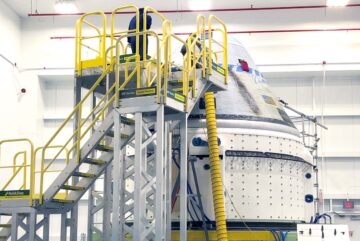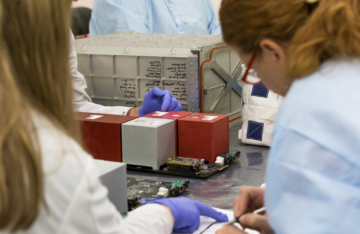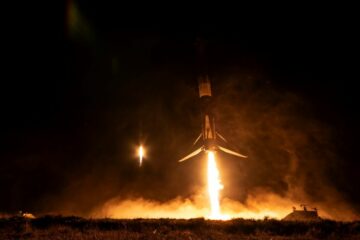The latest U.S. military budget goes all-in on the notion that resilience will be a core feature of space programs. As evidence, the term surpasses 300 mentions in the Space Force’s 2024 budget documents.
“It’s amazing how many times you see the word resiliency in the budget justification materials,” said analyst Sam Wilson of the Aerospace Corporation’s Center for Space Policy and Strategy.
The emphasis on resilience — or adaptability in the face of attacks — reflects the priorities set by the new chief of space operations Gen. Chance Saltzman. The running theme in the budget is the need to ensure U.S. access to space and shore up capabilities to compete with space powers like China and Russia.
“China, our pacing challenge, is the most immediate threat in, to, and from space for which the Space Force must maintain technological advantage,” Saltzman said in testimony to the Senate Armed Services Committee earlier this year.
“Russia, while less capable, remains an acute threat that is developing asymmetric counter-space systems meant to neutralize American satellites,” said Saltzman.
‘Competitive endurance’
A push for resilience is part of a multifaceted strategy Saltzman rolled out in March called “competitive endurance” to guide Space Force plans to deter and combat adversaries.
Vice Chief of Space Operations Gen. David “DT” Thompson said the Space Force’s central responsibility is ensuring U.S. military forces and allies have access to satellite services.
And that is why resilience is so critical, he said June 15 at the Defense One Tech Summit.
“Ukraine showed that proliferation works. It leads to resilient architectures,” Thompson said, referring to Russia’s repelled attempts to jam SpaceX’s Starlink internet satellite service used by Ukrainian forces.
The U.S. armed forces and allies today rely on a secure space infrastructure — for communications, early warnings of ballistic missile attacks and other services — that the Space Force provides from a relatively small number of geostationary satellites in harder to reach orbits. “And we have to continue to understand how to defend and protect those against counter-space attacks,” he said.
“I think that’s probably the biggest concern right now,” Thompson said, “ensuring we have enough resilience in both proliferated constellations, and those small numbers of larger systems to be able to defend them.”
A shift to proliferated constellations is already under way.
The Space Development Agency — a procurement organization under the Space Force — is moving forward with a multibillion dollar plan to field a mesh network of satellites in low Earth orbit for missile warning and for data transport. The agency in April launched its first batch of 10 satellites and announced plans to launch its next 13 spacecraft in late July.
Proliferation and redundancy make the loss of a few satellites tolerable, said Thompson, and bolster deterrence because targeting them imposes increased cost on an adversary.
This is how the Space Force plans to deal with China’s threats in the long term, he said. “We are in a long competition with China. They absolutely believe that.”
“We can’t look at a finish line in this competition,” Thompson added. “We have to think what we need to do to compete for the next 10 to 50 years.”

Avoid surprises
Space Force’s competitive endurance strategy has three tenets: avoid operational surprise, deny first-mover advantage, and conduct responsible counter-space campaigns that don’t create long-lasting debris in orbit.
“If we get this right we will deter a crisis or conflict from extending into space,” Lt. Gen. DeAnna Burt, deputy chief of space operations, cyber and nuclear, said in an interview.
“But if needed, we will ensure space access for the joint force in a manner that maintains safety in the space domain for all responsible actors.”
Avoiding unwelcome surprises in space requires continuous awareness of what adversaries are doing in orbit, she said.
The U.S. wants to prevent a Pearl Harbor-style attack in space, which is why the Space Force is turning more attention to space domain awareness, Burt said. “I have to be able to attribute any actions that are nefarious; I have to track and maintain custody of things I consider threats, and provide indications and warnings to other people.”
The second tenet, denying first mover advantage in space, is where resilient architectures play a central role, she explained.
“If the enemy knows that attacking U.S. interests in space will require such a massive effort that it will become impractical or self-defeating, we will be deterring such actions in the first place,” she said. “It would be a case when the juice isn’t worth the squeeze.”
The final tenet, conducting responsible counter-space campaigns, is about the idea that, if American assets were threatened, the U.S. would respond appropriately and would try to minimize the creation of debris in orbit.
“Polluting the domain is not what I want to do,” said Burt. There are ongoing discussions with allies about how operations could be conducted in a responsible manner, she said.
The Space Force has been secretive about what technologies it might be developing to attack adversaries’ satellites without creating significant debris.
“General Saltzman has publicly talked about deliveries that will come in the 2026 timeframe,” Burt said. “And I think that’s when you’re going to see us start to figure out how we’re going to message that.”
Access to space
China and Russia have adopted strategies based on disabling adversaries’ space communications and navigation systems, said Brig. Gen. Anthony Mastalir, commander of U.S. Space Forces Indo-Pacific, a subordinate unit to U.S. Indo-Pacific Command.
It is stunning how fast China has modernized its space infrastructure to enable military capabilities like precision-guided missiles, Mastalir wrote in a June 14 article published by the Air University’s Journal of Indo-Pacific Affairs.

“China has made unprecedented investments in its on-orbit capabilities over the past three years,” Mastalir noted.
The U.S. military has been particularly wary of China’s secretive spaceplane — which has been described as a knockoff of the U.S. Air Force’s X-37B that can remain in orbit for years. China’s spaceplane has flown two long-endurance missions, and conducted proximity and capture maneuvers with a subsatellite, according to data from the commercial space-tracking firm LeoLabs.
Mastalir pointed out that China deployed about 160 satellites in 2022, many of which will support military operations. By some estimates, China plans to launch 200 spacecraft in 2023.
“While many strategists are rightly concerned about China’s and Russia’s fielding of anti-satellite weapons designed to degrade or destroy U.S. satellites in space, it is important to note that much of China’s space investment enables its long-range precision strike capability,” he wrote.
Space Force leaders also worry that a breakdown in U.S.-China communication and an underlying distrust that goes both ways could lead to miscalculations.
China’s lack of transparency about its own space activities makes it difficult to reduce those risks, Burt warned in May at a space policy conference hosted by Arizona State University.
Defense Secretary Lloyd Austin cautioned June 1 that China’s reluctance to engage with U.S. defense leaders could result in “an incident that could very, very quickly spiral out of control.”
More recently, Lt. Gen. John Shaw, deputy commander of U.S. Space Command, said the “biggest dynamic right now in our relationship with China with regard to space is a lack of communication and virtually zero transparency.”
The absence of dialogue and interaction creates conditions for “miscommunication, misperception, misinterpretation, and then things could go wrong. And that can happen in any domain,” Shaw said June 14 at the Secure World Foundation’s Summit for Space Sustainability.
U.S. Space Command traffic watchers at Vandenberg Space Force Base in California issue warnings of close approaches in orbit or potential collision to satellite operations and national agencies, including the Chinese government. But when warnings are sent to Chinese email addresses, Shaw said, “We never get a response. Never.”
“Even the Russians know how to communicate with us,” Shaw said. “We don’t have anything like that with the Chinese and that’s the biggest hindrance to transparent operations.”
‘Gray zone’ competition
Experts agree that space powers are most likely to attack rival satellites in a conflict through “non kinetic” means.
Still, both China and Russia have demonstrated they can blow up satellites by striking them with kinetic weapons such as ground-based missiles. However, the United States needs to be more concerned about activities that fall below the threshold of an act of war but are damaging nonetheless, said Todd Harrison, aerospace industry analyst and managing director of Metrea Strategic Insights.
Cyber and electronic jamming attacks are in the murky category of “gray zone” provocations that fall somewhere between low-intensity conflict and all-out war.

These non-kinetic attacks could still do lasting damage to satellites and their ground systems. A satellite that can’t see, think or communicate is as good as dead. “It’s probably going to be in the ground segment that you’ve got to be the most worried about, but it could be on the space side as well as there are now lasers that can blind sensors,” Harrison said.
“An adversary like China or others might think that they can get away with using that,” he said, “and could severely hamper our ability to sense and to communicate from space.”
The U.S. military “historically has not really had a good response to gray zone activities” and that should concern the Space Force, said John Klein, a senior fellow and strategist at Falcon Research, and adjunct professor at George Washington University’s Space Policy Institute.
“We kind of let it happen with no repercussions,” Klein said. “It doesn’t have to be a military response. But the U.S. has to make it known it’s unacceptable behavior, and that there will be consequences.”
It is notable, though, that the Space Force is openly talking about deterring China and about the importance of resilience in U.S. space networks, Klein said.
He observed that space resilience is not a new concept, as the Pentagon for decades has studied the issue of how to reduce the vulnerability of U.S. satellites.
“What is new is that the U.S. Space Force more specifically recognizes resilience as part of deterrence. It’s deterrence by denial of benefits,” Klein said. “It’s telling enemies that no matter what you do, it’s not going to matter. You’re not going to stop me.”
U.S. still vulnerable
A move to more diversified constellations is necessary but might still not be enough to deter China, warned Charles Galbreath, senior fellow for space power studies at the Air and Space Forces Association’s Mitchell Institute.
“While the proliferated LEO approach garners a great deal of attention, it is not the only method the Space Force can employ to increase the resiliency of its architecture,” Galbreath, former deputy chief technology and innovation officer of the U.S. Space Force, said June 26 at a Mitchell Institute event.
In a white paper titled “Building U.S. Space Force Counter-Space Capabilities,” Galbreath suggested the Space Force consider the “enduring military practice of deception to confuse adversaries and complicate their ability to target U.S. satellites.”
For example, the U.S. could build satellite payloads or components in ways that would camouflage their functions.
The Space Force also should expand its use of protection measures such as nuclear hardening and anti-jam systems, Galbreath said.
Speaking June 12 at the Mitchell Institute, Thompson, the vice chief of space operations, recognized that deterrence may work in theory but not in practice. And if diplomacy and deterrence fail, the military has to prepare for the worstcase scenario.
“This is where we’ve spent a lot of time working with the other services,” said Thompson, to make sure they understand their dependence on space assets and figure out how to ensure the Army, Navy and Air Force can continue operating if U.S. satellites were targeted.
Other discussions on this subject are taking place with the private sector, as the Space Force tries to figure out contracting options to secure access to commercial space services during conflicts.
Under an initiative known as Commercial Augmentation Space Reserves, the Space Force is looking at establishing agreements with companies to ensure that services like satellite communication and remote sensing are prioritized for U.S. government use during national security emergencies.
The role of the private space sector in national security is significant, said Thompson. “When you think about proliferation and diversity, it’s not just the number of satellites, it’s also allies and commercial partners.”
Need to keep space usable
Even if the U.S. has superior space technology, a vibrant private space sector and more powerful weaponry, the reality is that rival nations have the means today to destroy satellites and create “devastating impacts on the environment that will be harmful to the use of space for decades and perhaps centuries to come,” Thompson said.
“As we look at the proliferation of space capabilities, it will be increasingly difficult to deny some level of use of space to an adversary,” he added.
While preparing for a protracted competition with rival powers, said Thompson, the Space Force has to make sure the U.S. government has accurate intelligence so diplomats and military leaders know what’s happening in the space domain.
“If we’re operationally or strategically surprised, shame on us.”
This article originally appeared in the July 2023 issue of SpaceNews magazine.
Related
- SEO Powered Content & PR Distribution. Get Amplified Today.
- PlatoData.Network Vertical Generative Ai. Empower Yourself. Access Here.
- PlatoAiStream. Web3 Intelligence. Knowledge Amplified. Access Here.
- PlatoESG. Automotive / EVs, Carbon, CleanTech, Energy, Environment, Solar, Waste Management. Access Here.
- BlockOffsets. Modernizing Environmental Offset Ownership. Access Here.
- Source: https://spacenews.com/u-s-sharpens-plan-for-military-space-race/
- :has
- :is
- :not
- :where
- $UP
- 1
- 10
- 12
- 13
- 14
- 15%
- 160
- 1st
- 200
- 2022
- 2023
- 2024
- 2026
- 26
- 300
- 4th
- 50
- 50 Years
- a
- ability
- Able
- About
- absolutely
- access
- According
- accurate
- Act
- actions
- activities
- actors
- adaptability
- added
- addresses
- adopted
- ADvantage
- Aerospace
- Affairs
- against
- agencies
- agency
- agreements
- AIR
- Air Force
- All
- already
- also
- amazing
- American
- an
- analyst
- and
- Andrew
- announced
- Anthony
- any
- anything
- appeared
- approach
- approaches
- appropriately
- April
- architecture
- ARE
- arizona
- Arizona State University
- armed
- Army
- article
- AS
- Assets
- At
- attack
- Attacking
- Attacks
- Attempts
- attention
- austin
- avoid
- awareness
- away
- base
- based
- BE
- because
- become
- been
- behavior
- believe
- below
- benefits
- between
- Biggest
- blind
- Block
- blow
- bolster
- both
- Breakdown
- budget
- build
- but
- by
- california
- called
- Campaigns
- CAN
- Can Get
- capabilities
- capability
- capable
- capture
- case
- Category
- Center
- central
- centuries
- ceremony
- challenge
- Chance
- Charles
- chief
- China
- Chinas
- chinese
- class
- Close
- Colorado
- combat
- come
- commercial
- committee
- communicate
- Communication
- Communications
- Companies
- compete
- competition
- competitive
- components
- concept
- Concern
- concerned
- conditions
- Conduct
- conducted
- conducting
- Conference
- conflict
- Consequences
- Consider
- continue
- continuous
- contracting
- control
- Core
- Cost
- could
- Counter
- create
- creates
- Creating
- creation
- crisis
- critical
- Custody
- cyber
- damage
- damaging
- data
- David
- dead
- deal
- decades
- Defense
- Deliveries
- demonstrated
- dependence
- deployed
- deputy
- described
- designed
- destroy
- developing
- Development
- dialogue
- difficult
- Diplomacy
- diplomats
- Director
- discussions
- distrust
- diversified
- Diversity
- do
- documents
- Doesn’t
- doing
- Dollar
- domain
- Dont
- during
- dynamic
- Earlier
- Early
- earth
- effort
- Electronic
- emphasis
- enable
- enables
- enemies
- engage
- enough
- ensure
- ensuring
- Environment
- establishing
- estimates
- Event
- evidence
- example
- Expand
- explained
- extending
- Face
- FAIL
- falcon
- Fall
- FAST
- Feature
- fellow
- few
- field
- Figure
- final
- finish
- Firm
- First
- For
- Force
- Forces
- Former
- Forward
- from
- front
- functions
- Gen
- George
- Germany
- get
- Go
- Goes
- going
- good
- Government
- gray
- great
- Ground
- guide
- had
- happen
- Happening
- harder
- harmful
- Have
- hawaii
- he
- hindrance
- hosted
- How
- How To
- However
- HTTPS
- i
- idea
- if
- immediate
- Impacts
- importance
- important
- in
- incident
- Including
- Increase
- increased
- increasingly
- indications
- industry
- Infrastructure
- Initiative
- Innovation
- insights
- Institute
- Intelligence
- interaction
- interests
- Internet
- Interview
- into
- investment
- Investments
- issue
- IT
- ITS
- John
- joint
- journal
- jpg
- July
- june
- just
- Keep
- Kind
- Know
- known
- Lack
- larger
- lasers
- lasting
- Late
- latest
- launch
- launched
- lead
- leaders
- Leads
- LEO
- less
- let
- Level
- like
- likely
- Line
- Long
- Look
- looking
- loss
- Lot
- Low
- made
- magazine
- maintain
- maintains
- make
- MAKES
- managing
- Managing Director
- manner
- many
- March
- Mass
- massive
- materials
- Matter
- max-width
- May..
- me
- means
- meant
- measures
- Members
- mentions
- mesh
- Mesh network
- message
- method
- might
- Military
- minimize
- missiles
- missions
- more
- most
- move
- moving
- much
- MultiBillion
- multifaceted
- must
- National
- national security
- Nations
- Navigation
- necessary
- Need
- needed
- needs
- network
- networks
- never
- New
- new Chief
- next
- no
- notable
- note
- noted
- Notion
- now
- nuclear
- number
- numbers
- observed
- of
- Officer
- on
- ONE
- ongoing
- only
- openly
- operating
- operational
- Operations
- Options
- or
- Orbit
- organization
- originally
- Other
- Others
- our
- out
- over
- own
- Paper
- part
- particularly
- partners
- past
- pentagon
- People
- perhaps
- Peterson
- photo
- Place
- plan
- plans
- plato
- Plato Data Intelligence
- PlatoData
- Play
- policy
- potential
- power
- powerful
- powers
- practice
- Precision
- Prepare
- preparing
- prevent
- prioritized
- private
- private sector
- probably
- procurement
- Professor
- Programs
- protect
- protection
- provide
- provides
- publicly
- published
- Push
- quickly
- Race
- reach
- Reality
- really
- recently
- recognized
- recognizes
- reduce
- reflects
- regard
- relationship
- relatively
- reluctance
- rely
- remain
- remains
- remote
- repercussions
- require
- requires
- research
- reserves
- resilience
- resilient
- Respond
- response
- responsibility
- responsible
- result
- right
- risks
- Rival
- Role
- Rolled
- running
- Russia
- Russians
- s
- Safety
- Said
- Sam
- satellite
- satellites
- scenario
- Second
- secretary
- sector
- secure
- security
- see
- segment
- Senate
- senior
- sense
- sensors
- sent
- service
- Services
- set
- severely
- sharpens
- she
- shift
- should
- showed
- side
- significant
- small
- So
- some
- somewhere
- Space
- Space Force
- space race
- spacecraft
- SpaceNews
- Speaks
- specialist
- specifically
- spent
- Squeeze
- stand
- starlink
- start
- State
- States
- Still
- Stop
- Strategic
- Strategically
- strategies
- Strategist
- Strategy
- strike
- studied
- studies
- Stunning
- subject
- such
- Summit
- superior
- support
- sure
- surprise
- surprised
- surprises
- Sustainability
- system
- Systems
- taking
- talking
- Target
- targeted
- targeting
- tech
- technological
- Technologies
- Technology
- tenets
- term
- testimony
- that
- The
- the joint
- their
- Them
- theme
- then
- theory
- There.
- they
- things
- Think
- this
- this year
- thompson
- those
- though?
- threat
- threats
- three
- threshold
- Through
- time
- timeframe
- times
- titled
- to
- today
- track
- traffic
- Transparency
- transparent
- transport
- try
- Turning
- two
- u.s.
- U.S. Air Force
- U.S. government
- U.S. Navy
- U.S. Space Force
- Ukrainian
- under
- underlying
- understand
- unit
- United
- United States
- university
- unprecedented
- us
- usable
- use
- used
- using
- very
- vibrant
- vice
- virtually
- vulnerability
- Vulnerable
- want
- wants
- war
- warning
- washington
- Way..
- ways
- we
- Weapons
- WELL
- were
- What
- when
- which
- while
- white
- white paper
- why
- will
- Wilson
- with
- without
- Word
- Work
- working
- works
- world
- worried
- worry
- worth
- would
- Wrong
- wrote
- year
- years
- you
- zephyrnet
- zero










